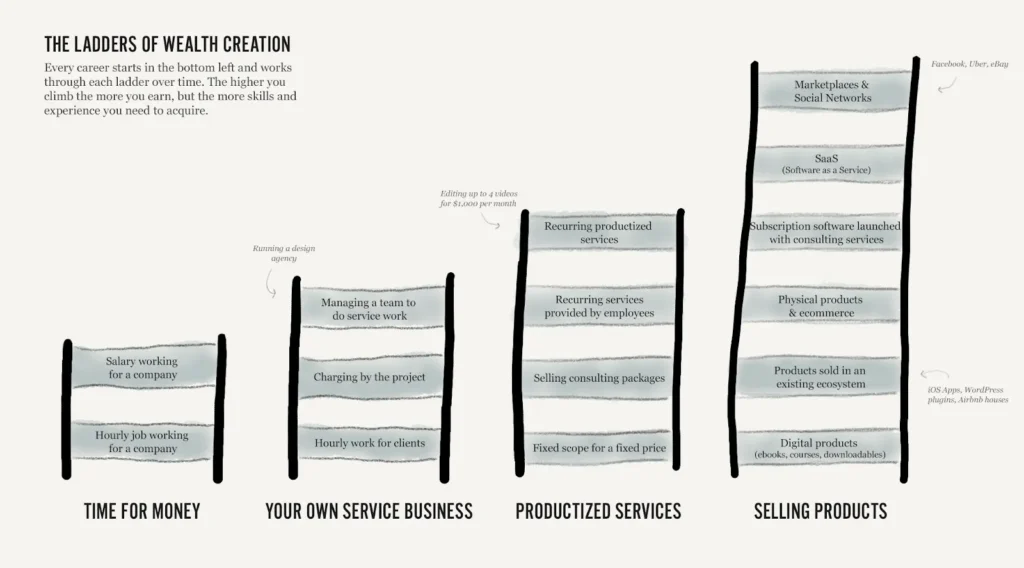Want to launch your own location-independent business and start traveling the world? That’s what I did two years ago.
I definitely made a lot of mistakes, but I also did a few things right. I grew my own business to $10k/month in just 30 days and hit 6 figures in under 10 months.
If I were to do it all over again, these are the five steps I’d follow.
Step 1 — Turn your digital skill into a service
Your goal is to build a business that 1) generates wealth and 2) gives you your time back. (Read about Nathan Barry’s Ladders of Wealth Creation if you have no idea what I’m talking about.)

And one of the best ways to do that is by leveraging a high-margin, productized service.
What’s your first step in building that service business? Identifying the service, of course.
Your mission in Step 1 is to find the sweetspot between …
- your skills,
- what the market needs,
- and how much they’re willing to pay for a service that checks both those boxes.
In order to find that sweetspot, you’ve got to do some soul-searching.
What are you good at? What do you enjoy doing?
This is the digital skill you’ll eventually turn into a service. And yes, choose a digital skill that you can perform and build a location-independent business around from anywhere in the world.
Then pick a niche (don’t worry – you don’t have to stick with that industry).
What problems do they face? How can the service you previously identified help them overcome those problems?
Ask yourself these questions for a couple different niches and you’ll find one that needs what you can offer.
Finally, make sure that market/niche is willing to pay big bucks for your service. Selling 25¢ services won’t make you wealthy unless you reach cataclysmic scale.
Step 1 accomplished ✅
Step 2 — Package & price that service
Now that you’ve identified your digital skill and target market, it’s time to turn that skill into a service that properly fills your market’s gaps.
Create 2-3 distinct tiers of your service. There are a couple ways to approach this:
Good, better, best
Championed by Rob Litterst, good better best is a common pricing strategy that software-as-a-service companies use.
Essentially, you need a few different levels of your service (e.g. “beginner, pro, premium”) that entice prospects to upgrade with time.
Each has key features but each upgrade unlocks new, better ones.
Done with you & done for you
This is a more common tiered pricing strategy for service companies like mine.
In my content marketing agency, we offer three tiers – two where we do the work by your side and show you how it’s done and the third where we do everything for you. The latter tier obviously being more expensive and white-glove.

(I recommend the packaged/tiered pricing or monthly retainer pricing. No other model comes close to giving you the freedom you want.)
The clearer these options are for different segments of your audience, the more business you attract and close.
And when it comes to pricing, it’s about the value you provide. So if your service will help your clients close 5 more deals this month, how much of those new clients’ payments do you deserve?
Do not price your packages in terms of how much time they take to provide. Always price higher than you think.
Step 3 — Find paying clients
Rely on your network
Likely the scariest part of your first few months of business is cold outreach. But without this step, you’ll never make any money.
What made this part of the process easier for me is my rolodex.
Before reaching out to complete strangers, work with friends and your current network first. (I made $13k in my first 45 days of business because of my network.)
The only downside of working with friends during your kickoff phase is the lack of honest feedback they’ll give you. So make sure they’re candid with their opinions.
Working with your current network is also a great way to get social proof in your early days.
Use their testimonials, logos and results to then reach out to others and prove your service actually works.
Reach out & stand out
Every day, your target market is inundated with horrible reachouts. Don’t add to the list.
Your goal is to stand out and break patterns with these internet strangers. How?
No matter how you deliver your cold message (email, phone call, social DM), it should not look or sound like every other message they receive.
Use a unique subject line, a gif, a video message (Loom), a personalized landing page – anything to make your message look different than everyone else’s.
Then, sound different too. Don’t just sell sell sell. Be helpful.
Point out their problem(s) politely, what it’s costing them, and provide value. Show you can help solve that problem and make them more money, increase their influence, etc.
Step 4 — Experiment
What is most important through these five steps is experimentation.
Test out several services. Test out several markets. Test out several packages and prices.
You will not nail your service, target market, packaging, or pricing on the first try. Do not assume you’re perfect.
I’m almost three years into running my own business, and I can’t tell you how many times I’ve tweaked my offer and target market.
Your start is the perfect time to experiment and explore.
The more customers conversations you have, the more mistakes you make, the more feedback you get, the more you’ll learn and adapt your services.
Your customers have a different, more serious problem that you can help them overcome? Boom! You’ve just identified a new service.
Flexibility is your best friend.
Step 5 — From freelancer to entrepreneur
Your goal is not to run your own business. Your goal is to control your own time and make as much money as possible. Right?
As a freelancer, that’s impossible. Instead, you’re a glorified employee – a slave to your clients and their wishes. Especially if you charge by the hour (never ever do this!).
If you delegate the low-leverage service delivery (aka the “work”), you can focus on higher-leverage stuff like growth and product development.
To become financially and time free, you have to shift hats from freelancer to business owner. Here’s how:

Build an audience
This is something I wish I had done far earlier: As you build your business, share what you know and document what you learn.
The goal?
To become a go-to figure for valuable info in your market. If you have a sizable audience, you also have a sizable sales pipeline.
Which do you prefer? Doing sales outreach and maybe getting one response every week? Or sending a single email to your list and booking multiple sales calls every time?
Yep, me too.
Then, you have more time to work on your business, not in it. You have more time to scale the company while delegating the low-leverage tasks like “doing” the service.
This is a key distinction.
Building an audience is not about vanity. It’s about building credibility with your target market and scaling your business.
Productize your services
Another key element to transitioning from a freelance service provider to an actual business owner is productizing your service.
This is a big leap.
Standardize your services, so they’re consistent, efficient, teachable and scalable. That way, every new client onboarding is easy and repetitive.
This efficiency gives you the chance to hire employees and grow your firm instead of you having to do the work forever.
You can launch and grow an online-first business. I’ve done it myself – twice!
I’ve seen it time and time again with our coaching program participants too. Our members go from 9-5 employees to thriving business owners in just six months.
If you’re willing to put in the work and adapt once in awhile, financial and time freedom is closer than you think.
If you have any questions about building your own online business, email or DM me.


